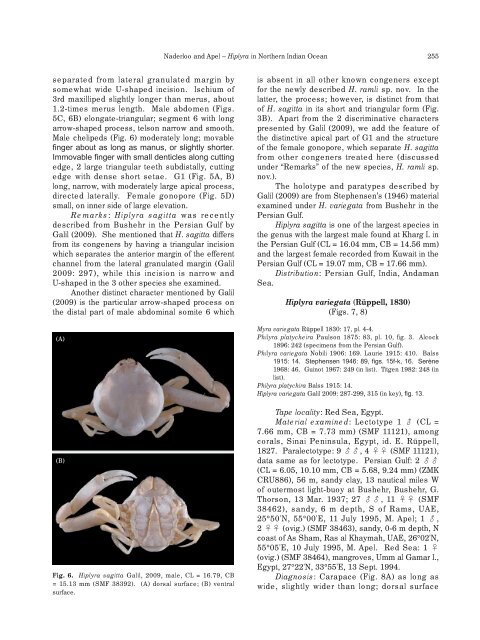Download PDF - Zoological Studies - Academia Sinica
Download PDF - Zoological Studies - Academia Sinica
Download PDF - Zoological Studies - Academia Sinica
You also want an ePaper? Increase the reach of your titles
YUMPU automatically turns print PDFs into web optimized ePapers that Google loves.
Naderloo and Apel – Hiplyra in Northern Indian Ocean 255<br />
separated from lateral granulated margin by<br />
somewhat wide U-shaped incision. Ischium of<br />
3rd maxilliped slightly longer than merus, about<br />
1.2-times merus length. Male abdomen (Figs.<br />
5C, 6B) elongate-triangular; segment 6 with long<br />
arrow-shaped process, telson narrow and smooth.<br />
Male chelipeds (Fig. 6) moderately long; movable<br />
finger about as long as manus, or slightly shorter.<br />
Immovable finger with small denticles along cutting<br />
edge, 2 large triangular teeth subdistally, cutting<br />
edge with dense short setae. G1 (Fig. 5A, B)<br />
long, narrow, with moderately large apical process,<br />
directed laterally. Female gonopore (Fig. 5D)<br />
small, on inner side of large elevation.<br />
Remarks: Hiplyra sagitta was recently<br />
described from Bushehr in the Persian Gulf by<br />
Galil (2009). She mentioned that H. sagitta differs<br />
from its congeners by having a triangular incision<br />
which separates the anterior margin of the efferent<br />
channel from the lateral granulated margin (Galil<br />
2009: 297), while this incision is narrow and<br />
U-shaped in the 3 other species she examined.<br />
Another distinct character mentioned by Galil<br />
(2009) is the particular arrow-shaped process on<br />
the distal part of male abdominal somite 6 which<br />
(A)<br />
(B)<br />
Fig. 6. Hiplyra sagitta Galil, 2009, male, CL = 16.79, CB<br />
= 15.13 mm (SMF 38392). (A) dorsal surface; (B) ventral<br />
surface.<br />
is absent in all other known congeners except<br />
for the newly described H. ramli sp. nov. In the<br />
latter, the process; however, is distinct from that<br />
of H. sagitta in its short and triangular form (Fig.<br />
3B). Apart from the 2 discriminative characters<br />
presented by Galil (2009), we add the feature of<br />
the distinctive apical part of G1 and the structure<br />
of the female gonopore, which separate H. sagitta<br />
from other congeners treated here (discussed<br />
under “Remarks” of the new species, H. ramli sp.<br />
nov.).<br />
The holotype and paratypes described by<br />
Galil (2009) are from Stephensen’s (1946) material<br />
examined under H. variegata from Bushehr in the<br />
Persian Gulf.<br />
Hiplyra sagitta is one of the largest species in<br />
the genus with the largest male found at Kharg I. in<br />
the Persian Gulf (CL = 16.04 mm, CB = 14.56 mm)<br />
and the largest female recorded from Kuwait in the<br />
Persian Gulf (CL = 19.07 mm, CB = 17.66 mm).<br />
Distribution: Persian Gulf, India, Andaman<br />
Sea.<br />
Hiplyra variegata (Rüppell, 1830)<br />
(Figs. 7, 8)<br />
Myra variegata Rüppell 1830: 17, pl. 4-4.<br />
Philyra platycheira Paulson 1875: 83, pl. 10, fig. 3. Alcock<br />
1896: 242 (specimens from the Persian Gulf).<br />
Philyra variegata Nobili 1906: 169. Laurie 1915: 410. Balss<br />
1915: 14. Stephensen 1946: 89, figs. 15f-k, 16. Serène<br />
1968: 46. Guinot 1967: 249 (in list). Titgen 1982: 248 (in<br />
list).<br />
Philyra platychira Balss 1915: 14.<br />
Hiplyra variegata Galil 2009: 287-299, 315 (in key), fig. 13.<br />
Tape locality: Red Sea, Egypt.<br />
Material examined: Lectotype 1 (CL =<br />
7.66 mm, CB = 7.73 mm) (SMF 11121), among<br />
corals, Sinai Peninsula, Egypt, id. E. Rüppell,<br />
1827. Paralectotype: 9 , 4 (SMF 11121),<br />
data same as for lectotype. Persian Gulf: 2 <br />
(CL = 6.05, 10.10 mm, CB = 5.68, 9.24 mm) (ZMK<br />
CRU886), 56 m, sandy clay, 13 nautical miles W<br />
of outermost light-buoy at Bushehr, Bushehr, G.<br />
Thorson, 13 Mar. 1937; 27 , 11 (SMF<br />
38462), sandy, 6 m depth, S of Rams, UAE,<br />
25°50'N, 55°00'E, 11 July 1995, M. Apel; 1 ,<br />
2 (ovig.) (SMF 38463), sandy, 0-6 m depth, N<br />
coast of As Sham, Ras al Khaymah, UAE, 26°02'N,<br />
55°05'E, 10 July 1995, M. Apel. Red Sea: 1 <br />
(ovig.) (SMF 38464), mangroves, Umm al Gamar I.,<br />
Egypt, 27°22'N, 33°55'E, 13 Sept. 1994.<br />
Diagnosis: Carapace (Fig. 8A) as long as<br />
wide, slightly wider than long; dorsal surface

















